The draft is an essential part of professional sports. It’s there to promote a level playing field. It gives those who finished with poor seasons a chance at the top players coming into the league, working as one aspect to create parity across that league. Plus, it’s just plain entertaining.
The four big leagues, the National Football League (NFL), National Basketball League (NBA), and Major League Baseball (MLB), National Hockey League (NHL), all run drafts for this reason. If you’re not in the running for the championship title, chances are you’re competing for the first-overall pick in the draft. That way, you get the first choice of all of the players available. A first-overall pick can change the entire outlook of an organization… or can it?
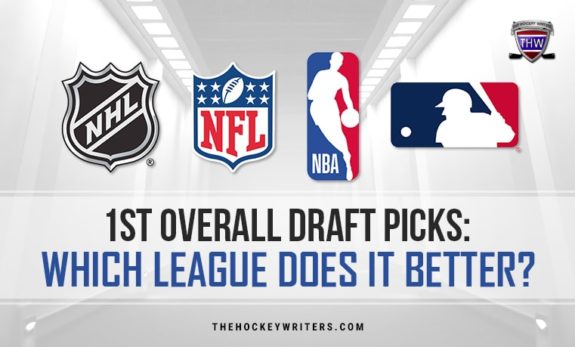
Just how well do these leagues make the first-overall pick in their respective drafts? Do some have it figured out better than others? To compare, I took a look at the 2000 to 2009 drafts in the four major sports leagues. Of course, it’s difficult to compare a player’s success in one league compared to another. Luckily for us, the analytics communities in all four sports can help with that with a variety of statistics that can be used to evaluate a player’s value in their league.
Here are the statistics we’ll be using:
NFL: Weighted Career Approximate Value (CarAV)
NBA: Win Shares (WS)
MLB: Wins Above Replacement (WAR)
NHL: Point Shares (PS)
In an extremely high-level description, all of these statistics work to compare players against their peers based on the value they bring to their team, in comparison to their teammates and those around the league.
Related: Is the First Overall Pick Always the Best Player in the Draft?
Before we look at how these leagues differ in their first-overall selections and which is best, we’ll have to take a look at each league and see if their top selection was/is even successful in their own league. To do this, we’ll look at a few things.
First, were they the best from their draft class in their respective statistic from above? Did they ever lead in their respective statistic in a season? Then, we’ll factor in if they could lead their team to a championship, did they win any individual accolades, and whether or not they have a case for their sport’s Hall of Fame.
At the end, we’ll take the information from each league, and compare it against the others to see which league has the most success with the first-overall pick.
NFL Draft: 2000 to 2009 First-Overall Picks
For the NFL, I’m using CarAV. Let’s take a look at the NFL’s first-overall picks from 2000 to 2009. The statistics are from pro-football-reference.com.
| Draft Year | Player | CarAV | Highest CarAV in Draft? (Difference) | Seasons Leading AV | Team Championship | Individual Awards |
| 2000 | Courtney Brown | 28 | No (-148) | 0 | 0 | 1x All-Rookie Team |
| 2001 | Michael Vick | 93 | No (-73) | 0 | 0 | 1x Player of the Year 4x Pro Bowl |
| 2002 | David Carr | 44 | No (-85) | 0 | 0 | 1x All-Rookie Team |
| 2003 | Carson Palmer | 108 | No (-2) | 0 | 0 | 3x Pro Bowl |
| 2004 | Eli Manning | 118 | No (-27) | 0 | 2 (2007, 2011) | 2x Super Bowl MVP 1x Man of the Year 4x Pro Bowl |
| 2005 | Alex Smith | 96 | No (-46) | 0 | 0 | 3x Pro Bowl |
| 2006 | Mario Williams | 76 | No (-35) | 0 | 0 | 4x Pro Bowl 1x First All-Pro Team |
| 2007 | JeMarcus Russell | 6 | No (-91) | 0 | 0 | None |
| 2008 | Jake Long | 55 | No (-80) | 0 | 0 | 4x Pro Bowl 1x First All-Pro Team |
| 2009 | Matthew Stafford* | 95 | Yes (+11) | 0 | 0 | 1x Pro Bowl |
Hall of Fame average Weighted Career AV: 90.05*
*This statistic only goes back to 1950
The NFL is an interesting beast. Players can be excellent at the college levels, but then fall flat when it comes time to hit the NFL. Looking at the first-overall picks from this decade, only one of them led their draft class in Weighted Career AV: Matthew Stafford. Based on that statistic, this was the only draft where the best player was selected.
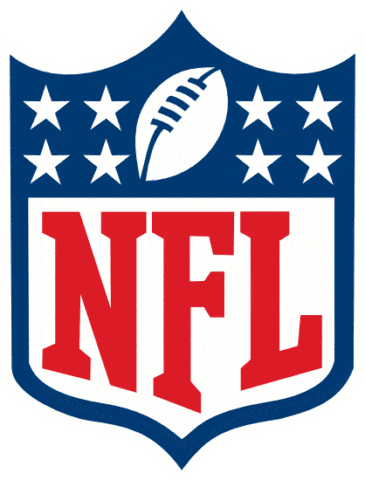
What’s interesting is that not one of these players led a single season in AV. While a number of these players have had stellar campaigns, they weren’t statistically the best player in the league for any single season. However, both Michael Vick (2010 Player of the Year) and Eli Manning (2016 Man of the Year) were recognized as the top players. Also, Manning was the only player to help lead his team to a Super Bowl Championship.
That being said, nine of the 10 players were recognized in some way – especially in the Pro Bowl, where seven players were honoured (six of them multiple times).
The last item to look at is the Hall of Fame eligibility. Of course, a lot more goes into this honour than CarAV, but it’s a good evaluator when comparing these 10 players to the best to ever play the game. The average is 90.05 for Hall of Fame players, putting five of these players drafted in the ’00s into that conversation.
Based on this evaluation, here’s how the NFL has scored in its first-overall pick selections:
Highest CarAV in Draft: 1/10
Seasons Leading AV: 0/10
Leads Team to Championship: 1/10
Individual Awards/Honours: 9/10
Above Hall of Fame Average: 5/10
TOTAL: 16/50
While there were some very good players drafted first overall in the NFL over this time, the most alarming discovery is that only one of them was statistically the best player of their draft class. The NFL may need to re-evaluate how they scout their prospects.
NBA Draft: 2000 to 2009 First-Overall Picks
For the NBA, I’m using WS. Here are the NBA’s first-overall picks from 2000 to 2009. The statistics are from basketball-reference.com.
| Draft Year | Player | WS | Highest WS in Draft (Difference) | Seasons Leading WS | Team Championships | Individual Awards |
| 2000 | Kenyon Martin | 48.0 | No (-15.3) | 0 | 0 | 1x All-Rookie Team 1x All-Star Game |
| 2001 | Kwame Brown | 20.8 | No (-123.3) | 0 | 0 | None |
| 2002 | Yao Ming | 65.9 | No (-26.6) | 0 | 0 | 8x All-Star Game 5x All-NBA Team 1x All-Rookie Team Hall of Fame Inductee |
| 2003 | LeBron James* | 263.1 | Yes (+142.4) | 5 | 3 (2012, 2013, 2016) | 16x All-Star 15x All-NBA Team 6x All-Defensive Team 4x MVP 3x Final MVP 3x All-Star MVP 1x All-Rookie Team 1x RoTY 1x Scoring Champion |
| 2004 | Dwight Howard* | 133.9 | Yes (+37.1) | 0 | 0 | 8x All-Star 8x All-NBA Team 5x All-Defensive Team 5x TRB Champion 3x Def. PoTY 2x BLK Champ 1x All-Rookie Team |
| 2005 | Andrew Bogut | 50.6 | No (-128.9) | 0 | 1 (2015) | 1x BLK Champion 1x All-Rookie Team 1x All-NBA Team 1x All-Defensive Team |
| 2006 | Andrea Bargnani | 18.9 | No (-92.5) | 0 | 0 | 1x All-Rookie Team |
| 2007 | Greg Oden | 7.3 | No (-134.4) | 0 | 0 | None |
| 2008 | Derrick Rose* | 39.7 | No (-61.6) | 0 | 0 | 3x All-Star 1x All-Rookie Team 1x RoTY 1x All-NBA Team 1x MVP |
| 2009 | Blake Griffin* | 75.2 | No (-58.1) | 0 | 0 | 6x All-Star 5x All-NBA Team 1x All-Rookie Team 1x RoTY |
Hall of Fame average WS: 98.95
Having LeBron James drafted in this decade seems to give a slight boost to the statistics here. Overall, this looks very similar to the NFL. Only two players were able to lead their draft class in career WS, in James and Dwight Howard. This stat is one that carries the most weight in this analysis since it provides a numerical value for the players. It shows that 80% of the time, NBA teams aren’t drafting the right player.
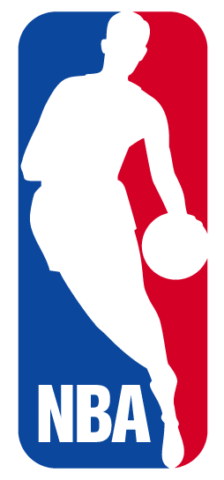
But of course, there’s more should factor in. If it wasn’t for James being in here, no players would have led a single season in WS. That’s very telling, in that there were always players outperforming them. Yet, two of them won a league MVP (James and Rose).
While only two won championship titles in the careers (so far), nearly all of them have been recognized individually. They might not have been the best player in their draft class, but they have still been honoured for their performance as one of the top players in the league at one point or another.
Looking at the names on this list, a surprising finding is that only two of them have above the average WS of a Hall of Fame player. Again, James and Howard. However, it’s important to remember that this is just the average and Yao Ming, who is well below the average, is already in the Hall of Fame.
Based on this evaluation, here’s how the NBA has scored in its first-overall pick selections:
Highest WS in Draft: 2/10
Seasons Leading WS: 1/10
Leads Team to Championship: 2/10
Individual Awards/Honours: 8/10
Above Hall of Fame Average: 2/10
TOTAL: 15/50
This is one point shy of what the NFL scored, but the stats are very similar. The teams are drafting very good players (for the most part), but these players tend to not be the best of their draft class. At this point, is this an error in scouting in these two sports, or sport in general?
MLB Draft: 2000 to 2009 First-Overall Picks
For the MLB, we’ll be using WAR. Let’s take a look at the MLB’s first-overall picks from 2000 to 2009. All statistics are from baseball-reference.com.
| Draft Year | Player | WAR | Highest WAR in Draft (Difference) | Seasons Leading WAR | Team Championships | Individual Awards |
| 2000 | Adrián González | 43.6 | No (-20.8) | 0 | 0 | 5x All-Star 4x Golden Glove 2x Silver Slugger |
| 2001 | Joe Mauer | 55.3 | Yes (+0.1) | 0 | 0 | 6x All-Star 5x Silver Slugger 3x Golden Glove 3x Batting Title 1x MVP |
| 2002 | Bryan Bullington | -0.2 | No (-71.2) | 0 | 0 | None |
| 2003 | Delmon Young | 3.2 | No (-56.9) | 0 | 0 | 1x ALCS MVP |
| 2004 | Matt Bush | 2.6 | No (-69) | 0 | 0 | None |
| 2005 | Justin Upton* | 34.4 | No (-12.4) | 0 | 0 | 4x All-Star 3x Silver Slugger |
| 2006 | Luke Hochevar | 3.7 | No (-64.2) | 0 | 1 (2015) | None |
| 2007 | David Price* | 39.4 | No (-5.9) | 0 | 1 (2018) | 5x All-Star 2x ERA Title 1x Cy Young |
| 2008 | Tim Beckham* | 3.5 | No (-38.3) | 0 | 0 | None |
| 2009 | Stephen Strasburg* | 33.5 | No (-39.3) | 0 | 1 (2019) | 3x All-Star 1x Silver Slugger 1x WS MVP |
Hall of Fame average WAR: 42.30
Well, we seem to be getting worse. The MLB had just one player that held the best WAR from their draft class, Joe Mauer, and even he was only 0.1 point above number two.
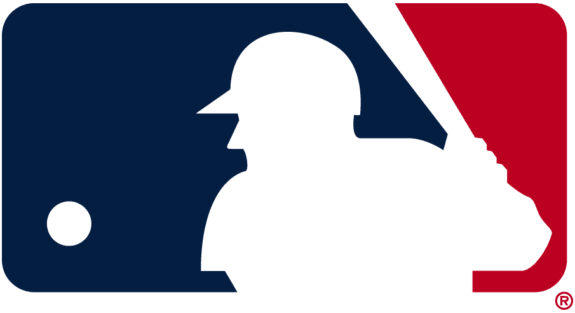
None of these players led WAR in a season, making it seem likely that this isn’t a realistic statistic when evaluating the success of a player. Coming into this analysis, my thought process was that if you’re taking a player first overall, you’d expect that they can be the best player in a season.
We do have our highest number of championships won (three) from a first-overall pick, which is better than the NFL and NBA at least. Still, didn’t you imagine that this number would be higher? When you get the first-overall pick, the hope is that you’re getting a foundational player that you can build around. This would come with the ultimate goal of winning a championship.
The individual accolades come in as the lowest of any league, with four players never receiving recognition. Plus, only one has won a league MVP – again, Mauer. This can go hand-in-hand with the low number of players that are above the Hall-of-Fame average: only two.
Based on this evaluation, here’s how the MLB has scored in its first-overall pick selections:
Highest WAR in Draft: 1/10
Seasons Leading WAR: 0/10
Leads Team to Championship: 3/10
Individual Awards/Honours: 6/10
Above Hall of Fame Average: 2/10
TOTAL: 12/50
The MLB has the longest draft of any league, with the most selections, so there’s a higher chance of the first-overall pick not being the best player of that class. But still, this is proving that the value of the first-overall pick might be overvalued in sport. While there’s certainly a higher chance of that player being everything you’d hope for, very rarely does it lead to a championship in any sport.
NHL Draft: 2000 to 2009 First-Overall Picks
Finally, for the NHL we’ll use PS, which is similar to the NBA’s WS. Here are the NHL’s first-overall picks from 2000 to 2009. Similar to the leagues above, all statistics are from hockey-reference.com.
| Draft Year | Player | PS | Highest PS in Draft (Difference) | Seasons Leading PS | Team Championships | Individual Awards |
| 2000 | Rick DiPietro | 49.3 (GPS) | No (-124) | 0 | 0 | None |
| 2001 | Ilya Kovalchuk* | 103.4 | No (-17.5) | 0 | 0 | 2x All-Star Team 1x Rocket Richard Trophy |
| 2002 | Rick Nash | 102.6 | No (-13.4) | 0 | 0 | 1x Rocket Richard Trophy |
| 2003 | Marc-Andre Fleury* | 147.7 (GPS) | Yes (+30.5) | 0 | 3 (2009, 2016, 2017) | None |
| 2004 | Alex Ovechkin* | 172.4 | Yes (+42) | 1 | 1 (2018) | 12x All-Star Team 8x Rocket Richard Trophy 3x Hart Trophy 3x Lester B. Pearson Trophy 1x Art Ross Trophy 1x Conn Smythe Trophy 1x Calder Trophy |
| 2005 | Sidney Crosby* | 154 | Yes (+21) | 0 | 3 (2009, 2016, 2017) | 8x All-Star Team 3x Lester B. Pearson Trophy 2x Rocket Richard Trophy 2x Hart Trophy 2x Art Ross Trophy 2x Conn Smythe Trophy 1x Mark Messier Leadership Award |
| 2006 | Erik Johnson* | 54.2 | No (-44.9) | 0 | 0 | None |
| 2007 | Patrick Kane* | 119.2 | Yes (+34.9) | 1 | 3 (2010, 2013, 2015) | 4x All-Star Team 1x Hart Trophy 1x Lester B. Pearson Trophy 1x Art Ross Trophy 1x Conn Smythe Trophy 1x Calder Trophy |
| 2008 | Steven Stamkos* | 108.5 | Yes (+5.7) | 0 | 0 | 2x All-Star Team 2x Rocket Richard Trophy |
| 2009 | John Tavares* | 90.9 | Yes (+8.6) | 0 | 0 | 1x All-Star Team |
Hall of Fame average PS: 82.9
The NHL surprised me in this, in that they led nearly every category in comparison to the other leagues. In the other three leagues, the average number of players that were the best of their class was 1.33. For the NHL, having six players at the top is a massive jump. If we were looking at this stat alone, the NHL would lead.
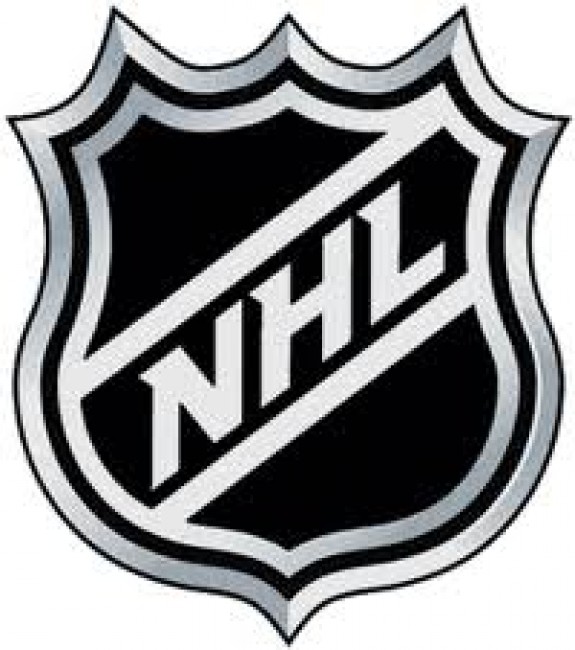
The statistic that has hurt leagues the most in this exercise is leading the league for a season in their respective statistic. The NHL is no different, having only two players lead the league in PS in a season in Alex Ovechkin and Patrick Kane. Personally, I was surprised to not see Sidney Crosby do that as well as a generational talent. Again, perhaps this isn’t a good evaluation of success.
The NHL was also the best in leading the team to a championship, having four players do so in Marc-Andre Fleury, Ovechkin, Crosby, and Kane. They’re also right on point with the individual accolades compared to the other leagues but have had the most league MVP awards (Hart Trophy) with three.
Related: 1st Overall Draft Picks – What are the Odds of Success?
Finally, the NHL also leads in having their first-overall picks over the Hall of Fame average. You can argue whether or not they are actually worthy of the distinction or not, but there’s no questioning the value they’ve had on their teams.
Based on this evaluation, here’s how the NHL has scored in its first-overall pick selections:
Highest PS in Draft: 6/10
Seasons Leading PS: 2/10
Leads Team to Championship: 4/10
Individual Awards/Honours: 7/10
Above Hall of Fame Average: 8/10
TOTAL: 27/50
If you were to look at just the 27/50 rating, you might not be that impressed. But when including the analysis of the NFL, NBA, and MLB, this is actually very impressive. Most impressive is the NHL’s ability to actually choose the best player in the draft more often than not.
NFL, NBA, MLB, and NHL First-Overall Picks: Who Does it Best?
Coming into this, I decided on the statistics I would base this evaluation on before looking at the numbers, so I couldn’t skew them in one way or another. Based on these criteria, the NHL is not just the best at drafting first overall, but is the best by a wide margin. Here’s the overall ranking:
- NHL: 27/50
- NFL: 16/50
- NBA: 15/50
- MLB: 12/50
If we were to base it solely on that player being the best in their respective stat, here’s how the leagues stack up:
- NHL: 6/10
- NBA: 2/10
- NFL & MLB: 1/10
This was the most alarming statistic, especially in the NFL, NBA, and MLB. These leagues are nearly always missing the best player in the draft, or the player that brings the most value to their team, with the first-overall pick. With the amount of time and money that these leagues put into scouting, is something going wrong in the process?
If there’s anything to take away from this piece, it’s that perhaps getting the first-overall pick isn’t as valuable as it’s believed to be (especially in the three leagues other than the NHL). What might be more valuable, is having a higher number of picks. You never really know when you might be drafting the best player of the draft.
What are your thoughts? Do you agree with the findings here? Is the first-overall pick overvalued? Leave a comment!